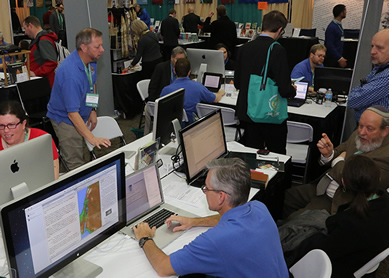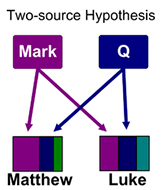Imagine buying the latest best-selling novel and coming across this in its first lines: “It was the best of times, it was the worst of times, it was the age of wisdom, it was the age of foolishness.” Even if you don’t know that the sentence is the opening of Charles Dickens’ classic A Tale of Two Cities, you might recognize it as a famous quotation and realize that the author has borrowed it. You might wonder, is this author plagiarizing a famous passage outright, or is she creatively adapting it for her own purposes?
Many people read the canonical gospels and notice that the stories and sayings of Jesus are also strikingly similar. In particular, the Gospels of Matthew, Mark, and Luke often include the very same words and stories in the very same order—which is rather astonishing, given the flexibility of their original language, Greek. An ancient Greek author could arrange his words in many different ways without changing their meaning. Because of these remarkable similarities, scholars call Matthew, Mark, and Luke the Synoptic Gospels. Synopsis means “see together” in Greek, so the label “synoptic” indicates that these gospels are seen or studied together. The Gospel of John is written in a different style and tells a slightly different sequence of events, so it is not included among the Synoptic Gospels.
How did the Synoptic Gospels end up with such similar accounts? Although many stories about Jesus were passed down by word of mouth, the strong agreements in wording and sequence suggest that there must be a literary relationship among the Synoptics. The question of the literary relationship among these gospels is also known as the Synoptic Problem. The Synoptic Problem includes such questions as: Did the authors of the Synoptic Gospels know one another? Was one gospel a source for the others? Did all of the Synoptic Gospels use a common source?
Although there are different ways of solving the Synoptic Problem, most scholars agree that the Gospel of Mark was a source for the Gospels of Matthew and Luke. This conclusion follows from two main observations. First, Matthew and Luke generally follow the same chronology that Mark outlines (though this would also be the case if Mark were conflating Matthew’s and Luke’s versions, a scenario first proposed by Johann Jakob Griesbach in the 18th century). Second and more importantly, Matthew and Luke often elaborate on or improve Mark’s versions of his stories. Consider the well-known scene in which Jesus is baptized (Matt 3:13-17; Mark 1:9-11; Luke 3:21-22). Mark’s version raises the uncomfortable question of why an inferior person such as John would have to baptize Jesus, the Son of God. Matthew and Luke not only recognize this concern, but also attempt to make sense of it in different ways. Matthew has John question Jesus about the baptism and lets Jesus respond that it must occur to “fulfill all righteousness” (Matt 3:15). Thus, in his version Matthew “solves” the problem that Mark had left unaddressed. Similarly, Luke removes John the Baptist from the scene altogether by having him arrested by Herod (Luke 3:18-20), resolving Mark’s questionable scenario in a different way.
It seems that Matthew and Luke got their basic story from Mark, but they also share quite a bit of material that could not possibly have come from Mark—because Mark does not include it at all. This material includes the Sermon on the Mount/Plain (Matt 5-7; Luke 6:20-49), John the Baptist’s preaching in Matt 3:7-10 and Luke 3:7-9, the Lord’s Prayer (Matt 6:9-13; Luke 11:2-4), and the Parable of the Great Banquet (Matt 22:1-10; Luke 14:15-24), among other well-known passages. What’s more, Matthew and Luke even seem to know alternative versions of some stories they share with Mark. The Temptation story (Matt 4:1-11; Mark 1:12-13; Luke 4:1-13) and the Beelzebub Controversy (Matt 12:22-32; Mark 3:22-30; Luke 11:14-23), for example, are far more expansive in Matthew and Luke than in Mark. Therefore, many scholars think that Matthew and Luke had access to a second written source, which they call Q. Q is an abbreviation of the German term Quelle (meaning “source”), and it simply stands for the material that Matthew and Luke have in common that they did not take over from Mark. Since it is comprised mostly of sayings of Jesus, sometimes it is called the Sayings Gospel Q. Thinking about Q helps us to imagine the earliest years of the Jesus movement, when collections of Jesus’ sayings may have been circulating in oral and written form before, or even alongside, narratives about his life.
This solution to the Synoptic Problem is known as the Two-Source (or Two-Document) Hypothesis. In basic terms, this hypothesis accounts for the verbal and sequential similarities among the Synoptic Gospels by suggesting that Matthew and Luke used Mark and Q to compose their gospels. It is helpful to visualize these literary relationships with a chart:

Notice that there is no line between Matthew and Luke. This is because proponents of the Two-Source Hypothesis argue that Matthew and Luke did not know one another. Many have observed, for instance, that Matthew and Luke often change Mark and Q in very different ways. To provide just one example, Matthew places the saying on reconciling with one’s accuser or brother (Matt 5:25-26) within the Sermon on the Mount. Luke, on the other hand, inserts his version of the saying (Luke 12:58-59) after his presentation of the Sermon, within a wider unit about the importance of repentance for the end times.
But there are also alternative possibilities. Other scholars argue that Matthew may have known Luke’s work in addition to Mark’s, or that Luke may have known Matthew’s work in addition to Mark’s. If this is the case, then there is no reason to posit a source such as Q to account for the material that they have in common. On this model, the material that Luke and Matthew have in common that did not come from Mark can be explained by envisioning one author taking it over from his knowledge of the other’s use of such traditions. So if we suppose, for instance, that Luke knew Mark’s and Matthew’s gospels, then we could imagine him retaining Mark’s basic story and altering some of Matthew’s unique material in his own way. This hypothesis, referred to as the Farrer Hypothesis, can be visualized this way:

The Farrer Hypothesis is an interesting solution to the Synoptic Problem, because it allows us in theory to compare Luke’s attitudes to the two different sources that he was incorporating. On this model, we would see, for example, that Luke did not object to Matthew’s addition of a genealogy to Mark, but that he did want to alter the ancestors on which it focused. Moreover, Luke would have also approved of the Sermon that Matthew added to Mark, but he wanted to organize it in a somewhat different way and shift the sequence of some of Jesus’ teachings. Even more fascinating compositional scenarios could be entertained with the Griesbach Hypothesis, mentioned above, which envisions Mark conflating Matthew’s and Luke’s gospels. Regardless of how one solves the Synoptic Problem (the Two-Source Hypothesis, the Farrer Hypothesis, the Griesbach Hypothesis, or even another solution), these literary relationships do not amount to plagiarism in the modern sense. Many ancient authors relied upon sources without citing them the way we do today.
Can we definitively conclude which compositional scenario is “right”? Unfortunately, no. Solutions to the Synoptic Problem operate in the realm of plausibility and probability regarding what we know about the gospel authors and ancient compositional practices. But this uncertainty keeps the debate alive and invites people to continue to exercise their historical imaginations and explore how the Synoptic authors understood and used their sources.





